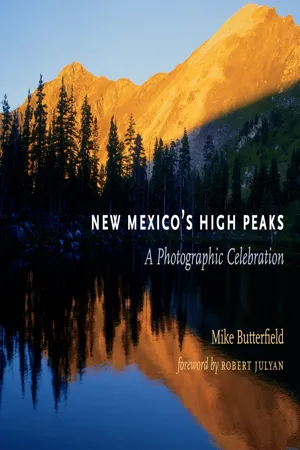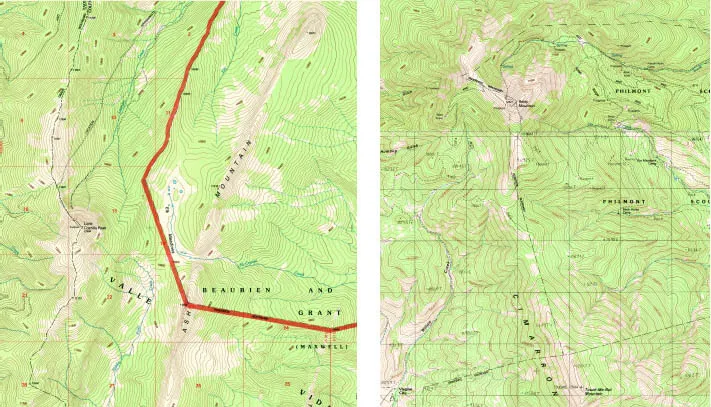![]() I THE NORTHERN RANGES
I THE NORTHERN RANGES![]()
CULEBRA RANGE
State Line Peak 12,867
Un-12,383 12,383
Un-12,450 estimated 12,450
Un-12,225 estimated 12,225
Vintrero 12,881
Big Costilla Peak 12,739
Un-12,931 12,931
The Culebra range, a prominent subrange of the Sangre de Cristo Mountains, is located primarily in Colorado and contains one of that state’s 14ers: 14,011-foot Culebra Peak. Culebra Peak misses being New Mexico’s highest summit, instead of being Colorado’s forty-first highest, by a mere 9 miles. From Culebra Peak, the peaks maintain a high profile before dropping in altitude just north of the New Mexico state line. Rising abruptly from its forested north slope is reclusive State Line Peak, whose actual summit lies a few hundred feet north of the New Mexico state line and introduces the Culebra range into New Mexico.
These peaks are on private property, and permission must be granted for access. Not located on public land and not within any wilderness, these mountains see limited use from the casual recreationist. They are seen to some effect from the north-south highway connecting Questa and Taos, New Mexico, from the west. They are best viewed from parts of SR 196, which cuts through the Valle Vidal, as well as from the trail that leads from Little Costilla Creek up Powderhouse Canyon toward Little Costilla Peak. For the most part, the peaks in New Mexico are high points on a rather flat-lying ridge, with little to distinguish one summit from another. Only from Little Costilla Peak’s summit to the east can the Culebra range be seen to good advantage.
The primarily Precambrian rocks of the Culebra range exhibit a gentle western aspect, while the east faces are more deeply incised by glacial action and display the steep faces and cirques typical of that environment. These east-facing cirques hold numerous small lakes, but with no established trail system, it is left to the more adventurous to discover these lake basins. Permission to access any of the land owned by the Rio Costilla Livestock Association must be made in advance. The best contact numbers are 575-586-0542 and 800-RIO-PARK. For more information on access to this mountainous area as well as to the northern Latir area, visit www.riocostillapark.com.
Comanche Point at the confluence of Little Costilla Creek and Comanche Creek in the Valle Vidal.
Viewed from high above Comanche Creek, near the confluence of Little Costilla Creek, the southern ramparts of the Culebra range can be seen, with the range’s highest summit, Un-12,931, on the right. On the extreme right, Big Costilla Peak can just be seen.
State Line Peak (12,867 feet) introduces the Sangre de Cristo Mountains to New Mexico. The peak’s highest point is a few hundred feet over the state line, so New Mexico’s claim to the peak is vague, yet the New Mexico high point is only a few feet lower than the Colorado high point, so most people include State Line as a New Mexico peak. Furthermore, the bulk of the mountain is in New Mexico, with a high ridge connection of over 12,000 feet to its nearest neighbor, Un-12,383 (the more diminutive summit on the left). The peak’s north flank drops to a low saddle, with more than 4.5 miles to the next high point.
The broad, flat summit of Vintrero (12,881 feet) from Little Costilla Peak. Although one of the state’s highest summits, Vintrero is almost unknown. Located on private property, its summit sees few visitors.
The Culebra range’s highest point (Un-12,931) as seen from Little Costilla Peak in the Valle Vidal. Even though most maps identify only Big Costilla Peak (12,739 feet), Un-12,931 is the true high point in the Culebra range in New Mexico. Big Costilla Peak (seen on the far right) rises approximately 189 feet from its connecting high saddle with Un-12,931. Therefore it does not meet the criteria for sovereign status.
CIMARRON RANGE
Little Costilla Peak 12,584
Baldy Mountain 12,441
Touch-Me-Not Mountain 12,045
The main Cimarron range borders the Moreno Valley to the west and has two main summits: Baldy Mountain and Touch-Me-Not Mountain. The high crest of the main Cimarron peaks is delineated by Mills Divide on their north side and the Cimarron River to the south, but high ridge connections can be traced north all the way to the South Fork Purgatoire River well into Colorado and south to the Tooth of Time Ridge within the Philmont Scout Ranch. Thus I have included Little Costilla Peak in this group. Separated by the Costilla Creek valley from the main Culebra crest, its claim to brotherhood with that group is dubious at best. Rising in parallel ridges trending north to south, including the Little Wall, the Wall, the Rock Wall, Ash Mountain, and finally the Vermejo Peak–Little Costilla Peak ridge, one can see the regional makeup of this area of peaks. Separating the north-south-oriented Valle Vidal and Moreno Valley by only a moderate east-west ridge and one pass, Windy Gap, the high ridge connection from Colorado to the Cimarron River, can be seen in its entirety.
The geologic record indicates rocks in the Cimarrons ranging in age from Precambrian (more than one billion years in age) to Tertiary (sixty-five million years and younger) with a vast gulf in time separating these rocks known as the Great Unconformity. They have been further intruded upon by widespread volcanic action. The most spectacular display is along the highway through Cimarron Canyon State Park, where a body of magma forcibly intruded along the Great Unconformity in this area, creating the vertical jointed rocks of the Palisades. The volcanic nature of the area can also be seen at Windy Gap, where the great dike known as the Rock Wall is breached. From the summit of Little Costilla Peak, evidence of volcanism is everywhere: from the Spanish Peaks north into Colorado to Ash Mountain; a long rhyolite dike just to the east of Little Costilla Peak and 1,000 feet lower.
The east slopes of Baldy and Touch-Me-Not are part of the Philmont Scout Ranch, and permission must be granted for access from that direction. The approach up Willow Creek from the Virginia City townsite north of Eagle Nest may be the best. Local inquiry should be made for this approach, as the land is on private property and permission may be needed for access. Touch-Me-Not is within the Colin Neblett State Wildlife Area, but the best approach to the mountain is from Willow Creek as well. The best view of these peaks is from Elizabeth-town just off Highway 38.
Little Costilla Peak can be approached by road and trail from either Powderhouse Canyon or Little Costilla Creek. Both of these approaches might best be done as an overnight trip due to the distance involved.
The Palisades along the Cimarron River.
The shortest approach for Little Costilla Peak is from the Clayton Corral on FR 1950 before Windy Gap. Some trail segments exist, and the hike is steep in spots. The opportunity to see wildlife on this approach mitigates the steep sections. One can return by way of the ridge west of Grassy Creek, with a short hike back to the car. The peak sees light visitation.
Little Costilla Peak is a somewhat reclusive peak and can be glimpsed onl...








